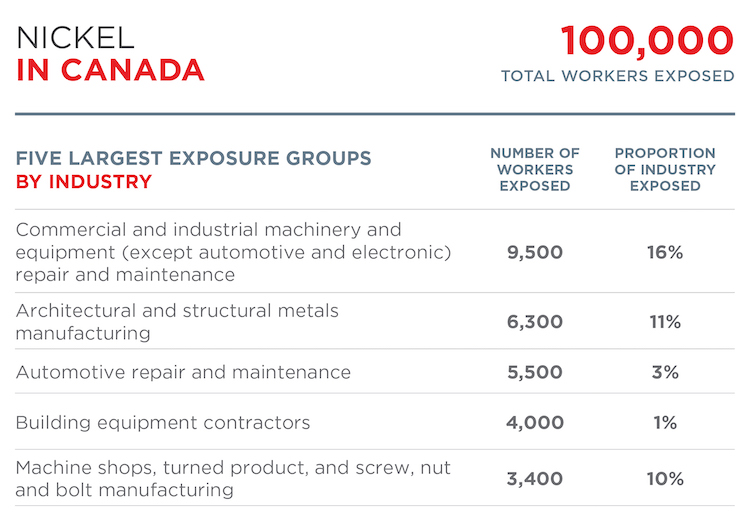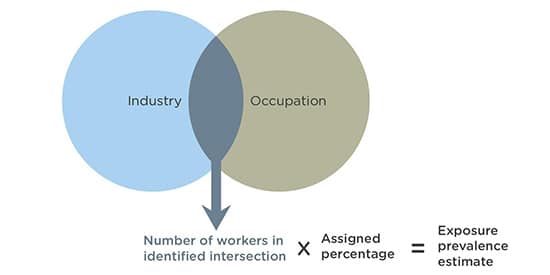Nickel Occupational Exposures
Nickel Occupational Exposures
Overview
The main routes of occupational exposure to nickel include inhaling particles and fumes, and dermal contact.[1]
CAREX Canada estimates that approximately 100,000 Canadians are exposed to nickel in their workplace. The largest industrial groups exposed to nickel are commercial and industrial machinery and equipment repair and maintenance, architectural and structural metals manufacturing, and automotive repair and maintenance.
READ MORE...
The largest occupational groups exposed to nickel are welders (working with stainless steel), followed by construction millwrights and industrial mechanics, and machining tool operators, and automotive service technicians and mechanics. Occupations that involve producing nickel alloy and stainless steel, welding, electroplating, grinding, and cutting operations may be exposed as well.[2]
According to the Burden of Occupational Cancer in Canada project, occupational exposure to nickel leads to approximately 170 lung cancers each year in Canada, based on past exposures (1961-2001).[3,4] This amounts to 0.7% of lung cancer cases diagnosed annually, and does not include the burden of lung cancer due to nickel exposure during welding, which is captured in the welding fumes estimate. Most occupational lung cancers associated with nickel exposure occur among workers in the manufacturing sector. These cancers also occur among workers in mining, oil, and gas extraction sector.[4]
Prevalence Estimate
Results show that approximately 100,000 Canadians are exposed to nickel in their workplaces; 91% of these workers are male. The largest industrial groups exposed are commercial and industrial machinery and equipment repair and maintenance (90% the exposed workers in this industry are classified as welders), architectural and structural metals manufacturing, and automotive repair and maintenance.
When examining nickel exposure by occupation, the largest groups exposed are welders (working with stainless steel) (48,000 workers exposed), followed by construction millwrights and industrial mechanics (7,300 workers exposed), machining tool operators (5,300 workers exposed), and automotive service technicians, truck and bus mechanics, and mechanical repairers (3,900 workers exposed).
The number of workers exposed to nickel decreased by approximately 17,000 workers from 2006 to 2016 (a 15% decrease). This was driven by a decrease in the total number of workers in manufacturing industries.
Workers exposed to nickel by industry in 2016

Workers exposed to nickel by region in 2016
Click the second tab to view total number of workers exposed.
* = < 50 workers
Level of Exposure
In total, approximately 100,000 Canadians are exposed to nickel and nickel compounds in their workplaces. The largest category of workers is exposed in the low category, while a number of nickel-exposed workers are at risk for moderate or high exposure.
Workers exposed to nickel by exposure level in 2016
Level of exposure by industry
Identifying industries with either 1) workers exposed to high levels of nickel and nickel compounds or 2) a larger number of workers exposed to nickel is important in guiding cancer prevention efforts to prioritize exposed groups and target resources most effectively.
The table below shows the number of workers exposed by industry group and level of exposure to nickel. These results highlight industries with the most number of workers, as well as industries with the highest levels of exposure.
For example, in the repair and maintenance industry, all of the exposed workers are in the low category. However, in fabricated metal product manufacturing (where workers are mainly exposed from welding of stainless steel), most of the workers are in the moderate and high categories of exposure. Depending on the goals of a prevention campaign, exposure reduction in the large industrial group might be a useful strategy, or reducing exposure to those at highest risk of exposure could be seen as a priority.
Workers exposed to Nickel by exposure level and industry in 2016
*Numbers may not add up due to rounding
Methods and Data
Our Occupational Approach page outlines the general approach used to calculate prevalence and exposure level estimates for workplace exposures.
Data Sources
Data used in developing the occupational estimates for nickel were collected from several sources:
- The Canadian Workplace Exposure Database (CWED) contains approximately 4,800 measurements for nickel exposure. These measurements were collected during the years 1981 to 2004 in Ontario and British Columbia workplaces
- Canadian and US scientific peer reviewed publications that addressed nickel exposure in Canada and the United States.
- Grey literature including technical reports from governments and international bodies.
Prevalence Estimate Method
CAREX defines exposure to nickel and its compounds (i.e. metallic nickel, nickel oxide, nickel sulphide, nickel sulphate, nickel chloride) as inhalation exposure at work to nickel containing-dusts and/or fumes at levels exceeding non-occupational exposure. Dermal exposure was not considered as exposed (i.e. handling of coins).
To determine the number of workers potentially exposed to nickel at work, CAREX occupational exposure experts used methods previously established in other peer-reviewed CAREX projects in Europe. A series of steps were taken to assign exposure proportions to occupations and industries at risk of exposure to nickel.

- Occupations and industries at risk of possible exposure to nickel were identified using any combination of data sources described above.
- The total number of workers in each identified occupation and industry intersection was obtained from Statistics Canada 2016 census data.
- A percentage of workers exposed was assigned to that occupation and industry intersection. Percentages were determined by consultation with existing evidence in the data sources, previously established methods from the Europe CAREX estimates and the expert judgement of CAREX occupational hygienists.
- The number of workers in the identified group is multiplied by the assigned percentage to calculate the prevalence estimate of workers exposed to nickel.
Exposure Level Method
CAREX uses available workplace exposure measurements in the CWED to create exposure level categories by industry and occupation. For nickel and its compounds, these categories are:
Category 1: Low Exposure
A group of workers (people in the same job category and industry) is put in this exposure category for one of two reasons:
- The are no valid measurements, but a hygienist identified this group as typically exposed during literature and other reviews;
- There are valid exposure measurements in the CWED and a hygienist review determined that exposure is plausible; AND EITHER:
- There are less than 10 samples available in the CWED, OR
- There are ≥10 measurements available but they do not meet the criteria for Moderate Exposure.
Category 2: Moderate Exposure
A group of workers is put in this exposure category if:
- There are at least 25 individual samples in the CWED, AND
- 20% or more samples have a value higher than 0.1 mg/m3 (which is the current occupational exposure limit for soluble nickel compounds).
OR
- There are at least 10, but less than 25, individual samples in the CWED, AND
- 20% or more samples have a value higher than 0.2 mg/m3(which is the current occupational exposure limit for insoluble nickel compounds).
Category 3: High Exposure
A group of workers is put in this exposure category if:
- There are at least 25 individual samples in the CWED, AND
- 20% or more samples have a value higher than 0.2 mg/m3 (which is the current occupational exposure limit for insoluble nickel compounds).
Sources
Subscribe to our newsletters
The CAREX Canada team offers two regular newsletters: the biannual e-Bulletin summarizing information on upcoming webinars, new publications, and updates to estimates and tools; and the monthly Carcinogens in the News, a digest of media articles, government reports, and academic literature related to the carcinogens we’ve classified as important for surveillance in Canada. Sign up for one or both of these newsletters below.
CAREX Canada
School of Population and Public Health
University of British Columbia
Vancouver Campus
370A - 2206 East Mall
Vancouver, BC V6T 1Z3
CANADA
As a national organization, our work extends across borders into many Indigenous lands throughout Canada. We gratefully acknowledge that our host institution, the University of British Columbia Point Grey campus, is located on the traditional, ancestral, and unceded territories of the xʷməθkʷəy̓əm (Musqueam) people.



